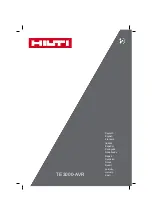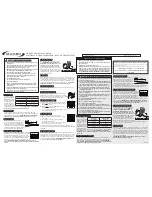
English
©1996 MHT Products, Inc. All rights reserved.
7
Heat Gun Model 2000D
The best method of paint removal
Move the gun slowly and steadily forward at an angle to the surface, pointing the nozzle
in the direction of motion. This allows you to scrape safely outside the hot air stream
and keeps the scraper and the scraped surface cooler.
A.
Warm air preheats the surface.
B.
Paint is softened by hot air.
A + B.
Deep penetration of heat over
total area.
C.
Paint can be easily scraped off
as soon as it is softened and
the gun is moved forward.
D.
Stripped surface allowed to
cool.
The removal of paint by heat gun is safe if the above guidelines are used, but
always keep either a container of water or an ABC fire extinguisher within reach.
Read the general operating and safety information sections of this owner's manual
before using the heat gun.
CLEANING AND MAINTENANCE
Keep the intake openings on the housing clean and free of obstructions. Us a soft, dry brush
to clean the openings periodically. Use only mild soap and a damp cloth to clean the heat gun.
Many household cleaners contain chemicals which could seriously damage the housing.
Do not use gasoline, turpentine, lacquer or paint thinner, dry cleaning fluids or similar
products when cleaning the heat gun. Never allow any liquid to get inside the tool or
immerse any part of the tool into a liquid.
STORAGE
Allow the heat gun nozzle to cool to room temperature before placing in storage.
The nozzle will turn dark over time because of the high heat. This is normal and will not
affect the performance or life of the unit.
CAUTION
Note: Do not use the heat gun on surfaces that can be damaged by heat, such
as vinyl-coated paneling, siding or window frames.
When removing paint from window frames, the heat gun will soften the putty. Be
careful not to gouge the putty with the scraper. The putty will firm up after it cools.
Do not use the heat gun on insulating laminated window glass such as
Thermopane. The glass edge expansion may break the edge seal.
When scraping fascia, do not overheat the edges of the asphalt
shingles protruding over the edge of the sheathing. Too much heat will
melt the asphalt.
A
B
C D
0283752E.qxd 4/9/03 11:26 AM Page 7








































